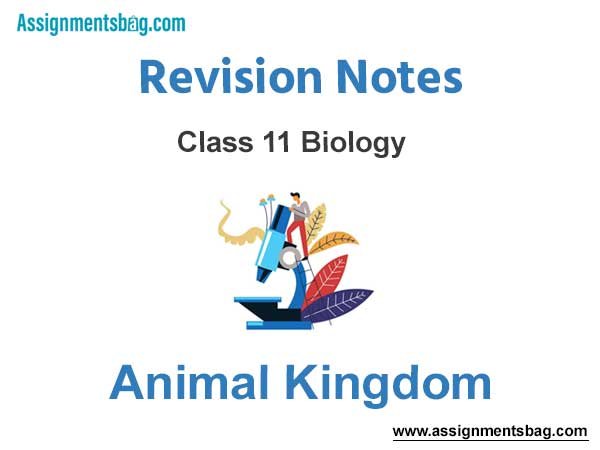Please see Animal Kingdom Class 11 Biology Revision Notes provided below. These revision notes have been prepared as per the latest syllabus and books for Class 11 Biology issues by CBSE, NCERT, and KVS. Students should revise these notes for Chapter 4 Animal Kingdom daily and also prior to examinations for understanding all topics and to get better marks in exams. We have provided Class 11 Biology Notes for all chapters on our website.
Chapter 4 Animal Kingdom Class 11 Biology Revision Notes
Animals are multicellular and heterotrophic organisms without cell wall and chlorophyll. Kingdom Animalia includes 11 major phyla:
1. Porifera
2. Arthropoda
3. Cnidaria
4. Mollusca
5. Ctenophora
6. Echinodermata
7. Platyhelminthes
8. Hemichordata
9. Aschelminthes
10. Chordata
11. Annelida
BASIS OF CLASSIFICATION:
1. Levels of organization
Based on this, animals are grouped into four levels:
a. Cellular level of organization: Here, the cells are arranged as loose cell aggregates. E.g. Porifera.
b. Tissue level of organization: Here, the cells are arranged into tissues. E.g. Cnidarians and Ctenophores.
c. Organ level of organization: Here, tissues are arranged into organs. E.g. Higher animals (Platyhelminthes to chordates).
d. Organ system level of organization: Here, organs are associated to organ system. Each system performs a specific physiological function. E.g. Higher animals. Organ systems of various animals show complexities. Digestive system is 2 types:
♦ Incomplete: It has only a single opening that acts as mouth & anus. Seen in Cnidaria and Platyhelminthes.
♦ Complete: It has 2 openings (mouth & anus).
Circulatory system is 2 types: open & closed.
2. Body symmetry
It is the arrangement of similar body parts on 2 sides of main axis of the body. Based on symmetry, animals are 2 types: Asymmetrical and Symmetrical.
a. Asymmetrical: Here, body cannot be divided into 2 equal halves. E.g. Most Poriferans, Snails etc.
b. Symmetrical: Here, body can be divided into 2 equal halves. It is 2 types.
♦ Radial symmetry: Here, body can be divided into 2 equal halves in any vertical plane along central axis (oral-aboral axis) of the body. E.g. some Poriferans, Cnidarians, Ctenophores and Echinoderms (adult).
♦ Bilateral symmetry: Here, body can be divided into right & left halves in only one plane.
E.g. Platyhelminthes to Chordata (except adult Echinodermata).
The body of bilaterally symmetrical animal has a dorsal side (upper), a ventral side (lower), left & right lateral sides, anterior (cephalic) side and posterior (anal or tail) side.
3. Germinal layers (Embryonic layers)
These are layers of embryo from which all the body organs are formed. Based on the number of germ layers, animals are 2 types- Diploblastic and Triploblastic.
a. Diploblastic animals: 2 germ layers- outer ectoderm and inner endoderm. In between these layers, an undifferentiated jelly-like layer called mesoglea is present. E.g. Cnidaria & Ctenophora.
b. Triploblastic animals: 3 germ layers- Outer ectoderm, middle mesoderm and inner endoderm. E.g. Platyhelminthes to Chordata.

4. Coelom (body cavity)
It is the cavity lined by mesoderm. It is seen between body wall and gut wall. Coelom separates the muscles of gut and body wall.
Based on the nature of coelom, animals are 3 types:
a. Acoelomate: No coelom. The space between body wall and digestive cavity is filled with matrix (parenchyma). E.g. Porifera to Platyhelminthes.
b. Pseudocoelomate: False coelom. Here, the body cavity is not lined by mesoderm. Mesoderm is scattered pouches. E.g. Aschelminthes.
c. Coelomate: True coelom. Here, the coelom arises from the mesoderm. Coelom is lined by peritoneal layer and filled with coelomic fluid. E.g. Annelida to Chordata.
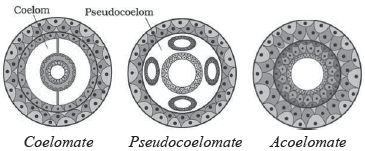
Functions of coelom:
♦ It accommodates visceral organs.
♦ Coelomic fluid reduces friction between visceral organs.
♦ It acts as shock absorber.
5. Metamerism (segmentation)
It is the phenomenon in which the body or organs is externally and internally divided into repeated segments (metameres). E.g. Annelids (earthworm etc.), Arthropods.
6. Notochord
It is a mesodermally derived supporting rod formed on the dorsal side during embryonic development in some animals. Animals with notochord are called chordates and those without notochord are called non-chordates.
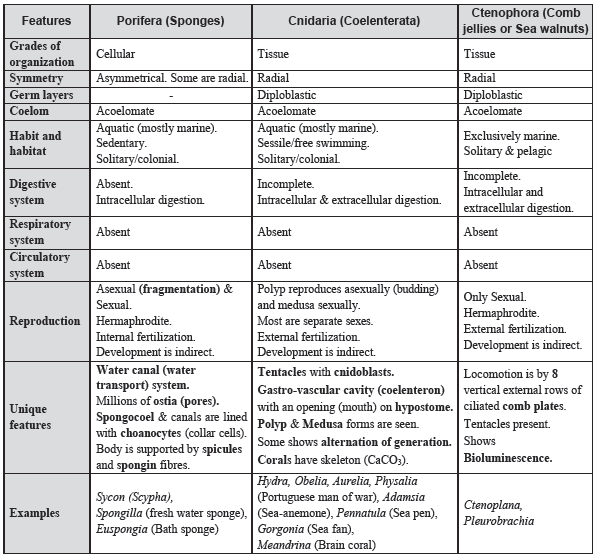
1. Water canal system: Here, water enters through minute pores (ostia) in the body wall into a central cavity (spongocoel), from where it goes out through osculum. Canal system is used for food gathering, gas exchange and removal of wastes.
2. Hermaphrodite (Monoecious): Male and female sex organs are seen in same individual.
3. Tentacles: Finger-like structures which surrounds the mouth of coelenterates. Used for food capture & defense.
4. Cnidoblasts (Cnidocytes): These are stinging cells (present on the tentacles and the body) with a poison-filled capsule called nematocyst. Cnidoblast is used for anchorage, defense and to capture prey.
5. Polyp & Medusa: 2 types of body forms in cnidarians.
Polyp is tubular attached asexual form, with upwardly directed mouth & tentacles. E.g. Hydra, Adamsia.
Medusa is umbrella like, free-swimming sexual form, with downwardly directed mouth & tentacles. E.g. Aurelia (Jelly fish).
6. Alternation of generation (Metagenesis): The phenomenon in which polyps produce medusae asexually and medusae form the polyps sexually. E.g. Obelia.
7. Bioluminescence: It is the property of some animals to emit light from the body.

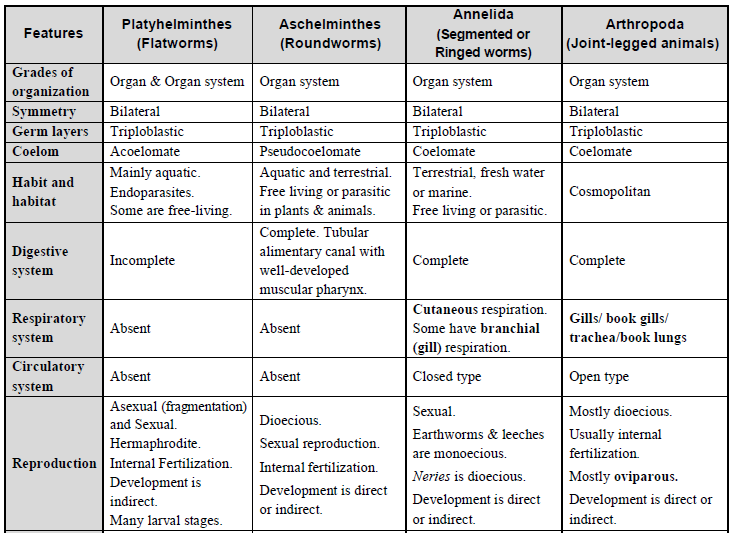

1. Dioecious: Sexes are separate.
2. Sexual dimorphism: Morphological differences between male and female.
3. Arthropoda is the largest phylum. Over two-thirds of all named species are arthropods

1. Mollusca: Mollusca is the second largest phylum.
2. Mantle (Pallium): The membrane which covers visceral mass. Space between the hump and mantle is called mantle cavity.
3. Radula: File-like rasping organ present in the mouth of molluscs. It is used for feeding.
4. Water vascular (ambulacral) system: In this system, sea water enters through a porous plate called madreporite and reaches the radiating canals and tube feet (podia). Its functions are locomotion, respiration, capture & transport of food and excretion.
5. Hemichordata was earlier considered as a sub-phylum of Chordata. Like chordates, it has pharyngeal gill slits.
PHYLUM CHORDATA
It includes animals with notochord, dorsal tubular nerve cord and pharyngeal gill slits.
Notochord is a flexible rod located in the mid dorsal line between the alimentary canal and the nerve cord in the embryo.

Differences between Chordata and Non-Chordata:
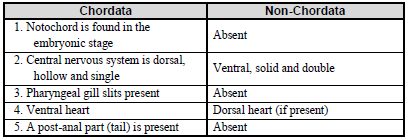
Phylum Chordata is classified into 3 subphyla: Urochordata, Cephalochordata & Vertebrata.

CLASS CYCLOSTOMATA
♦ All are ectoparasites on some fishes.
♦ Circulation is closed type.
♦ Elongated body without scales and paired fins.
♦ 6-15 pairs of gill slits for respiration.
♦ Sucking and circular mouth without jaws.
♦ Cartilaginous cranium and vertebral column.
♦ Marine, but migrate for spawning to fresh water. After spawning, they die. Their larvae, after metamorphosis, return to ocean.
♦ E.g. Petromyzon (Lamprey) and Myxine (Hagfish).
SUPERCLASS PISCES (FISHES)


SUPERCLASS TETRAPODA

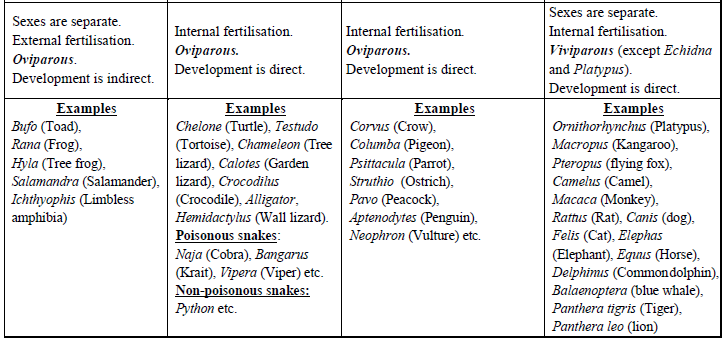
♦ Poikilotherms (Cold-blooded animals): Animals that lack the capacity to regulate their body temperature.
♦ Homoiotherms (warm-blooded animals): Animals having ability to maintain a constant body temperature.
